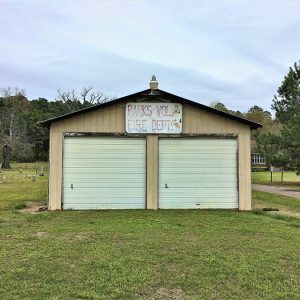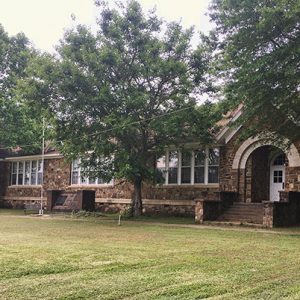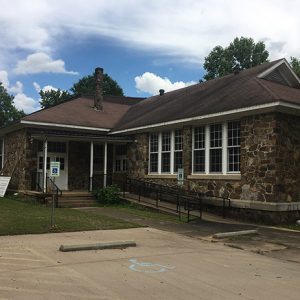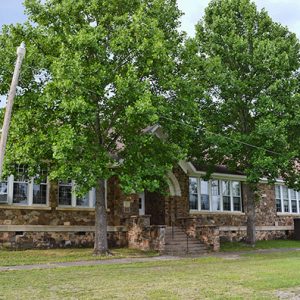calsfoundation@cals.org
Parks (Scott County)
Parks is an unincorporated community located along Highway 28 twelve miles southeast of Waldron (Scott County) in eastern Scott County. Originally known as White Church, it was established in 1838 along the Fourche La Fave River as an agricultural community.
The earliest people inhabited the area during the Archaic, Woodland, and Mississippian periods. Later inhabitants include Native American people of the Caddo tribe. Several thousand archaeological sites are located throughout the Fourche La Fave River valley, including small burial mounds.
During the late seventeenth and early eighteenth centuries, French hunters and tradesmen explored various portions of western Arkansas. These Frenchmen traversed rivers and streams throughout the region, including the Poteau, Petit Jean, and Fourche La Fave rivers. It is probable that they traveled through the area near present-day Parks.
During the late 1820s and 1830s, people began settling in eastern Scott County near Parks. In 1836, Cyrus Parks was elected justice of the peace for the area. By 1837, residents had established the town of White Church, which would later become Parks. White Church got its name from the white Methodist church that was built there in 1837. In 1838, the community of Parks established its first post office, with Cyrus Parks as the initial postmaster. The post office, named after Parks and thereby giving the community its new name, was one of the first in Scott County. The first postal road within the present boundaries of the county was laid out in 1838. Several businesses were established in Parks during the 1830s, including a general store, blacksmith shop, grist mill, and sawmill.
Parks’s first cemetery was established circa 1860 and is named after the Parks family. Several community members served in the Civil War, most of whom fought for the Confederacy. Hawkins Cemetery, named after the Hawkins family, was established just north of Parks circa 1864. The Parks Post Office was discontinued during early Reconstruction but was officially reinstated in 1870, with John McClain as the postmaster.
After Reconstruction, Parks continued to have economic growth, despite some of its institutional buildings being lost. In 1882, the Parks School District was established; however, the school was still referred to as White Church School. The school house burned in the late 1880s not long after its construction. A new two-story school building was quickly constructed in its place. In 1891, the Thompson School District was consolidated with Parks, increasing the size of the Parks school’s student body. That same year, the White Church Methodist Church burned down. By the 1890s, there were several stores in Parks, including one store owned by Clark Robertson that had slot machines. In 1893, the Parks Southern Baptist Church was established.
By 1907, Parks was receiving a telephone connection from the Waldron Telephone Company. In 1909, the Illinois Steel Bridge Company was contracted to build a steel bridge across the Fourche La Fave River just south of Parks. It is reported that the steel bridge, called the Frost Lane Bridge by locals, was the first to be constructed over the river. After World War I, several people in the Parks community contracted influenza during the 1918 Flu Epidemic.
In 1919, there were 175 pupils enrolled in the Parks School District. In 1921, the two-story school building in Parks burned down. In 1923, a frame school building was constructed as a replacement. An addition was made to the east wing in 1926 to accommodate an enrollment of 250 students.
During the Great Depression, many farmers and other citizens in Parks faced economic hardship. In 1936, work began on a new school house in Parks. The building was constructed out of local rock and organized as a project of the Works Progress Administration (WPA), which hired local men for the job. In 1940, the school building officially opened.
After World War II, the Parks High School was consolidated with Waldron, though the elementary and middle grades remained active. In 1966, the Parks school was officially closed after the consolidation with Waldron was complete.
Throughout the 1940s and 1950s, tent shows were a popular attraction in Parks. The promoters often set up a tent on the school grounds or near Dewey Williams’s blacksmith shop. The traveling tent show stayed in town for several days, showing a different movie each night. Pie suppers were also popular in Parks during this time period, including entertainment such as dancing, singing, and comedy.
The Parks school building, which was made into a community center, was placed on the National Register of Historic Places in 2002. The Parks Southern Baptist and Methodist congregations remain active in the twenty-first century, though they do not use the original nineteenth-century church buildings. Parks is served by the Parks Volunteer Fire Department. The post office at Parks is one of only a few remaining rural post offices in the county in the twenty-first century. Until the early 2000s, Parks had a gas station and store.
Residents of the area continue to farm, and hunting and fishing are popular recreational activities.
For additional information:
Cate, Michael. History of Scott County, Arkansas. Dallas, TX: Curtis Media Corporation, 1991.
Echoes: The Scott County Historical and Genealogical Society Quarterly. Waldron, AR: Scott County Historical and Genealogical Society (1986–).
Goodner, Charles. Scott County in Retrospect. Mansfield, AR: Frank Boyd, 1976.
Goodner, Norman. A History of Scott County, Arkansas. Siloam Springs, AR: Bar D Press, 1941.
McCutcheon, Henry Grady. History of Scott County, Arkansas. Little Rock: H. G. Pugh and Company, 1922.
Ty Richardson
Richardson Preservation Consulting
 Parks Post Office
Parks Post Office  Parks Volunteer Fire Department
Parks Volunteer Fire Department  Parks School House - Front
Parks School House - Front  Parks School House - Rear
Parks School House - Rear  Parks School House
Parks School House  Scott County Map
Scott County Map 



Comments
No comments on this entry yet.